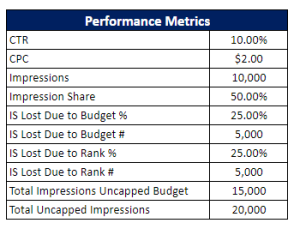PPC advertising budgets can be one of the most difficult tasks for marketers to figure out as there are many factors affecting this decision. But don’t worry, Synapse is here to help. While it may seem daunting, there are a number of valuable (yet often overlooked) metrics that can be instrumental in figuring out the optimal advertising budget based on your business and your goals. These include impression share and impression share lost due to budget:
- Impression share: The impressions you’ve received divided by the estimated number of impressions you were eligible to receive.
- Lost IS (Budget): The percentage of time that your ads were not shown on the Search Network due to insufficient budget.
Using these key metrics, we can project out PPC budgets based on your goals, to ensure your advertising efforts are effective and efficient. Here’s a step-by-step guide to help get you started:
Determine Your Advertising Goals
Are you looking to increase brand awareness, drive traffic to your website, or generate leads? Your advertising goals will help you determine how much you should be spending on advertising each month. Answering these questions can help determine how aggressive you want to be with your budgets.
Gather All Relevant Data
Pull the following data from the “Campaigns” tab (make sure to add any columns that are not already showing) for the last complete month of data to ensure you are using the most up-to-date statistics for your projection.
- Search Lost IS (Budget)
- Search Lost IS (Rank)
- Search Impression Share
- Impressions
- Clicks
- CTR
- Avg CPC
- Cost
Adjust Data to Create Average Monthly Numbers
Each month has a different number of days, and seeing that we are projecting an average month of budget, we need to proportionally adjust the data to create a true monthly projection. This applies to impressions, clicks, and cost:
Ex. (Impressions divided by number of days in the month) multiplied by 30.4 (average number of days in a month)
Calculate Actual Impression Numbers
In order to figure out the amount of spend needed to capture impressions lost due to low budgets, we need to figure out the actual number of eligible impressions:
Total Eligible Impressions = Impressions divided by Search Impression Share
Search Lost IS budget number = Search Lost IS Budget Percentage multiplied by Total Impressions Eligible For
Search Lost IS Rank number = Search Lost IS Rank Percentage multiplied by Total Impressions Eligible For
Calculate Uncapped Spend
Now we are ready to create projections based on the total number of eligible impressions:
Total Impressions Uncapped Budget = Impressions divided by Total Impressions Eligible For
Now that we have calculated these metrics, we can get a much clearer picture of how increasing the budget will impact performance. Your final inputs should look something like this:
From here, we can create monthly projections to see how increasing impression share through budget increases will impact clicks, conversions, and revenue:
In this example, we can see impressions, clicks, cost, conversions, customers, and revenue all increase by 50%. While the actual numbers increase, the metrics (CTR, CPC, CVR, etc.) stay the same. In reality, the actual numbers would likely not all increase at the exact same rate, but the purpose of this exercise is to provide an estimate of how increasing budget and impression share will affect overall performance.
Warning
One method of calculation to beware of is adding the percentage of impression share lost due to budget back to your current impressions. For example, if your campaign received 1000 impressions last month at a 50% impression share and you lost 25% due to budget, it may seem logical to take 25% of 1000 (250) and add that to your total impressions (1000+250=1250). This method is incorrect as it bases the Lost IS (Budget) number on impressions you received, not total eligible impressions. If you received 1000 impressions at a 50% impression share, that means you were eligible for 2000 total impressions. Therefore, the Lost IS (Budget) of 25% actually comes out to 500 lost impressions. So, if you add back the 500 lost impressions to the 1000 impressions you received, you can project to receive 1500 impressions by increasing your budget.
Conclusion
Understanding the metrics of impression share and impression share lost due to budget can be crucial in projecting PPC budgets and optimizing advertising efforts. By following the steps outlined in this guide, marketers can gather all relevant data, calculate actual impression share numbers, and ultimately create projections based on the total number of eligible impressions. Marketers can use these metrics to estimate how increasing budget and impression share will affect overall performance. By doing so, they can make informed decisions about advertising spend and achieve their advertising goals.
Contact us at paul@synapsesem.com if you’d like to subscribe to the Synapse SEM newsletter, or to learn more about our evolving search engine marketing services.



